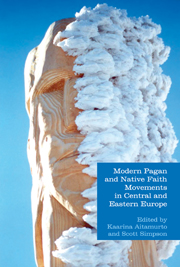Book contents
- Frontmatter
- Contents
- Contributors
- 1 Introduction: Modern Pagan and Native Faith Movements in Central and Eastern Europe
- Part I Overviews
- Part I Country Studies
- 6 Contemporary Paganism in Lithuanian Context: Principal Beliefs and Practices of Romuva
- 7 The Dievturi Movement in Latvia as Invention of Tradition
- 8 Polish Rodzimowierstwo: Strategies for (Re)constructing a Movement
- 9 Ukrainian Paganism and Syncretism: “This Is Indeed Ours!”
- 10 Russian Rodnoverie: Six Portraits of a Movement
- 11 Czech Neopagan Movements and Leaders
- 12 Neopaganism in Slovenia
- 13 Bulgarian Society and the Diversity of Pagan and Neopagan Themes
- 14 Romanian Ethno-Paganism: Discourses of Nationalistic Religion in Virtual Space
- 15 Neopaganism in Hungary: Under the Spell of Roots
- 16 Neopaganism in the Mari El Republic
- 17 A Neopagan Movement in Armenia: The Children of Ara
- Part III Thematic Studies
- Bibliography
- Index
7 - The Dievturi Movement in Latvia as Invention of Tradition
from Part I - Country Studies
- Frontmatter
- Contents
- Contributors
- 1 Introduction: Modern Pagan and Native Faith Movements in Central and Eastern Europe
- Part I Overviews
- Part I Country Studies
- 6 Contemporary Paganism in Lithuanian Context: Principal Beliefs and Practices of Romuva
- 7 The Dievturi Movement in Latvia as Invention of Tradition
- 8 Polish Rodzimowierstwo: Strategies for (Re)constructing a Movement
- 9 Ukrainian Paganism and Syncretism: “This Is Indeed Ours!”
- 10 Russian Rodnoverie: Six Portraits of a Movement
- 11 Czech Neopagan Movements and Leaders
- 12 Neopaganism in Slovenia
- 13 Bulgarian Society and the Diversity of Pagan and Neopagan Themes
- 14 Romanian Ethno-Paganism: Discourses of Nationalistic Religion in Virtual Space
- 15 Neopaganism in Hungary: Under the Spell of Roots
- 16 Neopaganism in the Mari El Republic
- 17 A Neopagan Movement in Armenia: The Children of Ara
- Part III Thematic Studies
- Bibliography
- Index
Summary
INTRODUCTION
In recent years, nearly every European society, including Latvia, has been faced with the emergence and growth of a variety of new religious movements (NRMs). Some NRMs are centered around the “re-invention” of pre- or non-Christian belief systems, such as Wicca, Asatru, the Goddess Movement, or Neo-Druids in France or Great Britain; Roman Gentilitas in Italy; and the various autochthonic movements of Neopaganism in Lithuania, Latvia, Estonia, and Ukraine. These NRMs oppose Christianity and reclaim a primordial European or national spirituality for themselves. The forms of such Neopagan belief systems and religious practices are mostly very heterogeneous across different groups and countries.
Dievturība stands apart from the mainstream of the global contemporary Neopagan movements like Wicca, the Goddess Movement, or the broad milieu of Pagan-influenced New Age, or even such well-known transnational movements such as Druidry or Asatru. For instance, Dievturība is usually not characterized as pantheistic, polytheistic, shamanistic, or magical religion oriented toward spirituality of nature. Individuals in Dievturi groups are searching for an “individual path to God.” Dievturība belongs to the branch of Neopaganism that, ignoring the long presence of Christianity in Latvia, strives to reconstruct the cultural legacy of those ancient Baltic peoples (including tribes such as Latgalians, Selonians, Zemgaļi, and Kurši) whose merger in the fifteenth and sixteenth centuries formed the Latvian people, language, and common culture. The reconstruction of this legacy does not have a global outreach; it is meant only for Latvians.
- Type
- Chapter
- Information
- Publisher: Acumen PublishingPrint publication year: 2013



